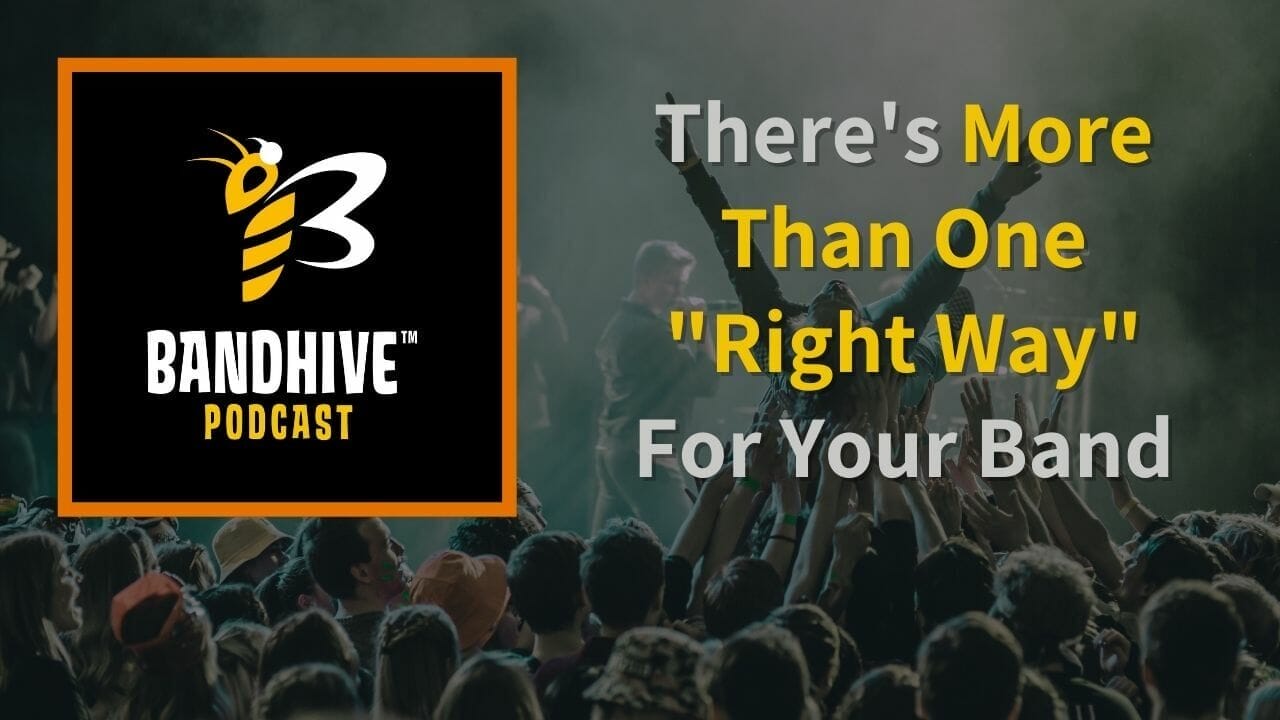[00:00:00] Welcome to episode 125 of the Bandhive podcast. It is time for another episode of the Bandhive podcast. My name is James Cross and I help independent artists tour smart this week. I'm going to talk about how there are multiple ways to achieve an outcome in almost any situation.
This was inspired by something that happened to me last night when I was working a show. But before I get into that, I'm going to give a little background because I cannot count how many times I've seen some music industry Experts say there's only one way to do something.
And you know, I'll be honest. Chances are, I've said that at some point too, the fact is there's lots of ways not to do something, but there is almost always more than one way to achieve the desired result. And which way you do things really depends on the factors, what your desired result is, what the situation is overall.
A lot of people say, this is the only way to do this. And you know what, in [00:01:00] some cases I'll give them that, you know, there are certain things that there's one way to do it, and that's just the best way to do it. It's tried and true, but there are a lot of other things where it's like, oh, this is the only way to market your band in 2020.
No, I don't necessarily agree. There are a lot of different audiences out there. So maybe if you say this is the only way to market your underground hardcore punk band. Sure. But an underground hardcore punk band is going to need a much different marketing plan than a pop artist. For example, like let's say you're doing electro pop, you're going to have a very different audience and that audience is going to react differently to the formats that are used.
So an underground punk band is probably not going to use the same tools that an electro pop artist would use. Now here's where my example comes in. And this is what inspired this episode is last night, I was mixing front of house for a benefit show that my good friend Vincent from the underground in Randolph, Vermont was putting together.
It was also being streamed. So [00:02:00] Vincent was mixing the stream. Most of the acts were solo acoustic. In fact, all of the apps were solo, acoustic, and most of them were using a DPI. which for those of you who aren't sound engineers, a DEI is when you just have the output from your acoustic guitar.
And it goes to the little box or straight into the mixer. If the mixer has um, DEI built in That DEI box, converts it to Mike level signal and goes to the mixer and you can mix it. You don't need to make up the guitar, but there were a couple acts that needed to have mikes on the guitar.
So we had a mic set up and ready to go. One of the acts got up on stage and we were doing this quickly. Each act was only playing two songs because it was mainly a benefit. So we said, you know what? Just get up there and play. That went well for most of the night, but there was one artist who she got up there and I realized there's no signal on the guitar.
I jumped up right away and grabbed the mic, which we'd set up for the artists without a DEI and started to set up. In the meantime, Vincent asked, oh, is your [00:03:00] 200 turned on? and this shows the different mindsets between what Vincent does, who has mainly a studio engineer and what I do where I have a lot of live sound experience, especially in radio broadcast, where everything is timed.
You have to be on time. You cannot be late. It's just, boom, boom, boom. You go, you go.
So the difference there is that Vincent is used to taking a step back to troubleshoot things, and I'm just in the mode of making it work. Now, I don't care. I don't have time make it work. Now, both solutions would have worked, but they stemmed from different approaches to the issue at hand.
Now I got to give it to Vincent. His move was better in this case because it wasn't time sensitive. And it was a very simple fix, but there have been times where I've been working with an artist and we spent several minutes trying to figure out what was wrong with a guitar and it just didn't work. And so we swapped out the guitar and I didn't want that to have to happen.
So I said, okay, this is an acoustic guitar we can make. Anyway, in this case, like I said, [00:04:00] Vincent method was probably the better approach. In fact, not probably it was. in a studio setting, my approach would have been totally wrong. You don't do that in a studio, in a studio. If something's not exactly the way you want it, you sit down and you troubleshoot it.
granted in the studio that guitar would have been miked up in the first place, rather than using a DEI, because it's not the greatest sound for. But in a fast paced radio broadcast environment, just getting things moving my method probably would have been better.
So what I'm trying to point out here is that there are three situations. There's the live show with an online stream time doesn't really matter so much. It's not strictly timed or anything like that, where both of these solutions would work. Then there's the studio where you want to take Vincent solution and just do everything as perfectly as you can and trouble.
Whatever it is until you have the perfect sound. And then there is the fast paced live environment where you can't delay anything and you just got to keep going. And so, even though both of our methods would have [00:05:00] worked in the situations where used to, when you bring it together to a situation, somewhere in the middle, between live and studio and broadcast, they both.
My point here is that the right thing to do depends entirely on the situation. You're in a lot of times you're going to see that there are multiple solutions to whatever it is you want to do. And they all work pretty much equally. in other cases, maybe there's only one solution.
It really depends on what situation you're in. the thing to keep in mind is that when we learn not to do something, we learn not to do it. That doesn't mean we shouldn't try other things because once we know what not to do, we can keep refining and finding new methods.
To see if those work, we shouldn't look at failure as failure. We should say, this didn't work. Now I've learned what not to do. So failure take that from a bad thing and turn it into a learning [00:06:00] experience because ultimately when you're running your own business, and I know I say this all the time, but being an artist that is a business, if you want to make a career out of it, it's absolutely a business.
It all comes down to you as a business owner, taking risks, using trial and error and learning from others than using that combination. We can discover new and potentially better ways to do things in the music. I really encourage you to try this. So take a step back and watch how other artists handle situations that you find yourself in.
Whether it comes to recording, playing live shows, marketing, releasing your music, whatever it is, see what other artists are doing, see what works and doesn't work for them and then try some new things for yourself. So if you see an artist that tries something and it doesn't work well, maybe that's not the best thing to try, but if they do something and it works really.
Maybe it's worth giving it a shot. If you can replicate that success by setting up the proper framework behind it, you don't want to just [00:07:00] jump into something and say, oh yeah, I can do that. And you know, do it, and then it doesn't work out. You want to have that plan in place because a lot of times what other artists are doing looks a lot easier than it really is.
So you don't want to just say, Hey, I can do that. It's going to take me five minutes and then you realize they spent weeks planning it out, even though the actual execution of it. Might've been five minutes. Just go out there and learn, learn what works in each situation and understand that there is not one right way to do things.
There are lots of wrong ways to do things and you absolutely want to avoid those. There is no one answer in most cases. So when you see somebody say, this is the only way to do this, you have to do it this way, or you're going to fail say, no, probably not.
I bet there's another way. you know what, I'm going to be the person to find that. And then this is going to be my idea and it's going to be unique and it's going to work better for me because I thought of it first.
That does it for this episode of the Bandhive podcast. Thank you so much for tuning in and [00:08:00] listening. I really appreciate it. And I hope that you will listen to this episode and think about new ways that you can do things in your band. Maybe it's something you've been doing for years and now with new technology, there's an easier way to do it.
Maybe it's something that you've just seen everyone else doing it. And you're a cop. Well, what if everyone else has it wrong, maybe you can come up with something better. So I would really love to hear what you come up with, what things you change in your business based on what I've been talking about in this episode.
So for every episode of the podcast, over in our Facebook group, which you can find by searching for Bandhive on Facebook, or by going to Bandhive.rocks/group, to get linked directly to the group. We have that discussion thread for every single episode.
So find the one for this episode, it's number 1 25 and let us know. What did you try after hearing this episode that you kind of thought, oh, this might work better than what I've been doing, or this might work better than what everyone else has.
I'm really curious to see what you can come up with because I know we have an [00:09:00] amazing creative community. So again, you can search for us on Facebook by looking for Bandhive. It's the group, not the page, or you can go to Bandhive.rocks/group.
we'll be back with another brand new episode next Tuesday at 6:00 AM Eastern time until then I hope you have a great week stay safe. And of course, as always keep rockin'.


